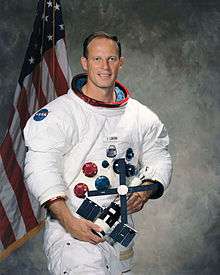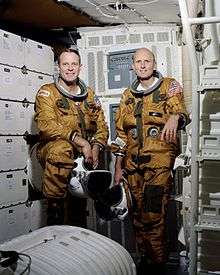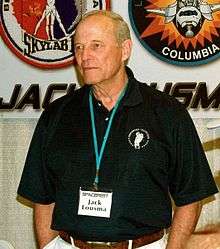Jack R. Lousma
| Jack R. Lousma | |
|---|---|
 | |
| NASA Astronaut | |
| Nationality | American |
| Status | Retired |
| Born |
February 29, 1936 Grand Rapids, Michigan, U.S. |
Other names | Jack Robert Lousma |
Other occupation | Naval aviator, engineer |
|
UMich, B.S. 1959 NPS, M.S. 1965 | |
| Rank | Colonel, USMC |
Time in space | 67d 11h 13m |
| Selection | 1966 NASA Group 5 |
Total EVAs | 2 |
Total EVA time | 11 hours 01 minute |
| Missions | Skylab 3, STS-3 |
Mission insignia |
|
| Retirement | October 1, 1983 |
| Awards |
|
Jack Robert Lousma (born February 29, 1936), (Col, USMC, Ret.), is an American aeronautical engineer, retired United States Marine Corps officer, former naval aviator, NASA astronaut, and politician. He was a member of the second manned crew on the Skylab space station in 1973. In 1982, he commanded STS-3, the third Space Shuttle mission.
Lousma was later the Republican nominee for a seat in the United States Senate from Michigan in 1984, losing to Carl Levin.
Biography
Early life and education
Lousma was born in Grand Rapids, Michigan, on February 29, 1936. He is of Frisian descent. He graduated from Angell Elementary School, Tappan Middle School, and Pioneer High School in Ann Arbor, Michigan in 1954;[1] Lousma received a Bachelor of Science degree in Aeronautical Engineering from the University of Michigan in 1959, and a Master of Science degree in Aeronautical Engineering from the U.S. Naval Postgraduate School in 1965; presented an Honorary Doctorate of Astronautical Science from the University of Michigan in 1973, an honorary D.Sc. from Hope College in 1982, and an honorary D.Sc. in Business Administration from Cleary College in 1986.
Lousma was a Boy Scout and earned the rank of Tenderfoot Scout.[2]
Military service
Lousma became a United States Marine Corps officer in 1959, and received his aviator wings in 1960 after completing training at the Naval Air Training Command. He was then assigned to VMA-224, 2nd Marine Aircraft Wing (2nd MAW), as an attack pilot and later served with VMA-224, 1st Marine Air Wing, at Marine Corps Air Station Iwakuni, Japan. He was a reconnaissance pilot with VMCJ-2, 2nd MAW, at Marine Corps Air Station Cherry Point, North Carolina, before being assigned to the Manned Spacecraft Center in Houston, Texas.
He has logged 7,000 hours of flight time; including 700 hours in general aviation aircraft, 1,619 hours in space, 4,500 hours in jet aircraft, and 240 hours in helicopters.
NASA career
Jack R. Lousma was one of the 19 astronauts selected by NASA in April 1966. He served as a member of the astronaut support crews for the Apollo 9, 10, and 13 missions. He famously was the CAPCOM recipient of the "Houston, we've had a problem" message from Apollo 13. He may have also been selected as Lunar Module Pilot for Apollo 20, which was canceled. He was the pilot for Skylab 3 from July 28 to September 25, 1973, and was Commander on STS-3, from March 22 until March 30, 1982, logging a total of over 1,619 hours in space.
Lousma also spent 11 hours on two spacewalks outside the Skylab space station. He also served as backup Docking Module Pilot of the United States flight crew for the Apollo-Soyuz Test Project (ASTP) mission which was completed successfully in July 1975. Lousma left NASA on October 1, 1983 and retired from the Marine Corps on November 1, 1983.[3]
Spaceflight experience

The crew on this 59½ day flight included Alan L. Bean (spacecraft commander), Lousma (pilot), and Dr. Owen K. Garriott who acted as a science-pilot. The crew installed six replacement rate gyros used for attitude control of the spacecraft and a twin-pole sunshade used for thermal control, and they repaired nine major experiment or operational equipment items. SL-3 accomplished 100% of mission goals while completing 858 revolutions of the Earth, and traveling some 24,400,000 miles in Earth orbit. They devoted 305 man hours to extensive solar observations from above the Earth's atmosphere, which included viewing two major solar flares and numerous smaller flares and coronal transients. Also acquired and returned to earth were 16,000 photographs and 18 miles of magnetic tape documenting earth resources observations. The crew completed 333 medical experiment performances and obtained valuable data on the effects of extended weightlessness on humans. Skylab 3 ended with a Pacific Ocean splashdown and recovery by the USS New Orleans.[4]

STS-3, the third orbital test flight of Space Shuttle Columbia, launched from the Kennedy Space Center, Florida, on March 22, 1982, into a 180-mile circular orbit above the Earth. Lousma was the spacecraft commander and C. Gordon Fullerton was the Pilot on this eight-day mission. Major flight test objectives included exposing the Columbia to extremes in thermal stress and the first use of the 50-foot Remote Manipulator System (RMS) to grapple and maneuver a Payload in space. The crew also operated several scientific experiments in the orbiter's cabin and on the OSS-1 pallet in the payload bay. Space Shuttle Columbia responded favorably to the thermal tests and was found to be better than expected as a scientific platform. The crew accomplished almost 100 percent of the objectives assigned to STS-3, and after a one-day delay due to bad weather, landed on the lakebed at White Sands, New Mexico, on March 30, 1982, the only shuttle flight to land at White Sands. Columbia traveled 3.4 million miles during 129.9 orbits of the earth and mission duration was 192 hours, 4 minutes, 49 seconds.
Political experience
In 1984, Lousma ran for the U.S. Senate as a Republican against Carl Levin, the incumbent senator from Michigan, but lost, receiving 47% of the vote. Lousma survived a bitter primary fight against former Republican congressman Jim Dunn to capture the nomination with 63% of the vote. Ronald Reagan's landslide reelection was a boon to Lousma, but he was hurt late in the campaign when video surfaced of him telling a group of Japanese auto manufacturers that his family owned a Toyota.[5] This did not play well in the Detroit area.
Personal life
Lousma and Gratia Kay were married in 1956. They have four children: Timothy J. (born December 23, 1963), Matthew O. (born July 14, 1966), Mary T. (born September 22, 1968), Joseph L. (born September 14, 1980); nine grandchildren, and one great-grandchild. A long time resident of Scio Township, near Ann Arbor, he moved with his wife to Texas in September 2013.[1]
Organizations
Lousma is a member of many organizations. He is a fellow of the American Astronautical Society; member of the Society of the Sigma Xi, the University of Michigan "M" Club, the Officers' Christian Fellowship, and the Association of Space Explorers.
Special honors
Lousma is a recipient of numerous awards. He was awarded the Johnson Space Center Certificate of Commendation (1970); the NASA Distinguished Service Medal (1973); presented the Navy Distinguished Service Medal and Navy Astronaut Wings (1974), the City of Chicago Gold Medal (1974), the Robert J. Collier Trophy for 1973, the Marine Corps Aviation Association's Exceptional Achievement Award (1974), the Fédération Aéronautique Internationale awarded him the V. M. Komarov Diploma for 1973, he also received the Dr. Robert H. Goddard Memorial Trophy for 1975, the AIAA Octave Chanute Award for 1975, the AAS Flight Achievement Award for 1974; inducted into the International Space Hall of Fame (1982); a second NASA Distinguished Service Medal (1982), the Department of Defense Distinguished Service Medal (1982), NCAA Silver Anniversary Award (1983); he is also inducted into the Michigan Aviation Hall of Fame (1988).
In media

In 1988, Lousma commentated on the STS-26 launch for ITN on British television, reflecting the media interest in the first Shuttle flight following the Challenger disaster. During the ascent, as Lousma described the abort modes as they became available, the show's host Alastair Burnet quickly asked Lousma which abort mode he preferred; "Abort to Orbit" came the quick reply.
Lousma was portrayed by Quinn Redeker in the 1974 TV movie Houston, We've Got a Problem.
References
- 1 2 "The Lousmas Say Good-bye", Ann Arbor Observer: 15, October 2013
- ↑ Jack R. Lousma at scouting.org Archived March 4, 2016, at the Wayback Machine.
- ↑ Lawrence, John (28 September 1983). "Lousma Retirement" (PDF). NASA News. p. 137. Retrieved 17 July 2013.
- ↑ Lousma's NASA Biography
- ↑ "Levin For The Senate". The Michigan Daily. 2 November 1984. p. 4. Retrieved 17 July 2013.
Lousma, on the other hand, recently confided to a meeting of Japanese business leaders that he owns a Toyota.
Bibliography
- Wright, Jerry, et al., "Astronaut biographies: Jack R. Lousma". National Aeronautics and Space Administration.
External links
| Wikimedia Commons has media related to Jack R. Lousma. |
- Lousma's official NASA biography
- Astronautix biography of Jack R. Lousma
- Spacefacts biography of Jack R. Lousma
- About Jack R. Lousma
- Jack R. Lousma at the Internet Movie Database
- Lousma at Spaceacts
- Lousma at Encyclopedia of Science
- Lousma at International Space Hall of Fame
